Abstract
Due to the COVID-19 pandemic, there was an urgent need to move to online teaching and develop innovative teaching techniques to ensure that student learning outcomes (SOs) were fulfilled. This paper tries to answer the important question of whether an established teaching strategy through a multi-course project-based learning (MPL) approach, along with online assessment techniques, helps in the effective achievement of SOs in a senior-level electrical engineering (EE) course. The authors have developed a course project for attaining the objectives of a senior and a capstone course, where students are registered at the same time. In addition, the course conducts assessments online. The paper reports the effect of the two approaches on the attainment of the SOs of the two courses, along with testing the programming and problem-solving abilities of the students. It is known that the MPL approach enhances the critical thinking capacity of students, which is also a major outcome of Sustainable Development Education (ESD). It was ensured that the project that was used to test the fulfillment of a series of SOs were concentrated on soft engineering and project management skills. The difficulty of adopting the MPL method for the senior-level courses is in the scheduling of the course materials to help the student advance to the final project while also aligning the project towards fulfilling the learning outcomes of the individual course. The study also provides the students with feedback on online assessment techniques incorporated within the MPL. Besides this, the effect of the innovative teaching approaches was compared with the same senior course taught using conventional methods in an earlier semester. Based on the feedback from teachers and students from a previously conducted case study, it was concluded that the MPL approach had supported the student learning. The results of the statistical analysis (Chi-square, two-tailed T statistics and hypothesis testing using a z-test) show that an MPL approach and online assessment improved the attainment of the SOs despite the constraints posed by the pandemic.
1. Introduction
To develop a sustainable, environment-friendly, and conscious society, it is advisable to use technology, innovation, and especially the active participation of student learners in university courses. The application of the above approaches involves a wide range of abilities, such as the creative resolution of problems and collective decision-making [1,2]. The traditional curriculum approaches need to be changed [3], and several creative instructional methods need to be implemented for making the students active observers and prepared with Education for Sustainable Development (ESD) skill sets, which are currently highly demanded [4,5,6,7,8,9]. Petousi and Sifaki in [10] conclude that new grounds for building trust and confidence in science are needed for sustainable development and to avoid harm in the form of normative dissonance for scientists and loss of trust in science. In a recent publication [11], the authors have highlighted an improvement in the learning outcomes as a result of the inclusion of ESD in the curriculum in the form of multi-course project-based learning (MPL), which is used as a guideline for the study discussed in this article. In their previous work [11], they stressed the applicability of MPL, i.e., a project which was used in the assessment of different courses. The main motivation of this approach was the students not being able to create a successful working prototype using the ideas provided in each course separately. Moreover, due to the workload of multiple projects in different courses, the students have a hard time dedicating time to each of the projects and thus do not get enough time to produce quality output. An MPL experience was shared in [12], where MPL was utilized in a software development assignment. In a recent work, researchers stressed the notion that realistic multi-course lessons in the form of a project would help to encourage students in understanding and applying their technical expertise to an engineering project [13,14]; this demonstrates how capability set deficiencies in traditional curricula were resolved by using the proposed approach of having a project span over multiple semesters. These studies do not report how the projects were planned and executed, and do not include a comprehensive comparative study in terms of efficacy. This paper gives a detailed overview of how, in a series of steps, the authors introduced an MPL (Figure 1). In addition to modifying the standard curriculum to integrate ESD, one of the main reasons for this case study was to affirm the success of a multi-course initiative in achieving student learning outcomes and promoting project-based learning (PBL). PBL aims to improve study methods while studying real-world problems and is appealing to learners as well [15]. A similar MPL was implemented by the authors in [11], where they used two junior level undergraduate Electrical Engineering courses and showed that such an implementation is appreciated by the students, while also successfully achieving the Student Learning Outcomes (SOs) for the courses involved. The authors have also shown via a step-by-step approach how such an implementation can be done for undergraduate level university courses. This approach could be further verified in the new education paradigm, i.e., online learning, due to the pandemic.
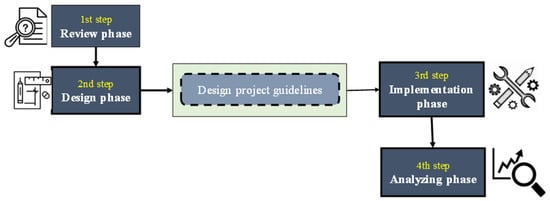
Figure 1.
Important phases of the research.
When the coronavirus disease 2019 (COVID-19) outbreak was declared as a global pandemic by the World Health Organization (WHO), education at all levels was significantly affected, and much research was carried out into innovative teaching methods to reduce the loss. Many articles discussed the approaches adopted to tackle the hindrances caused by the COVID-19 pandemic to medical studies [16,17,18,19,20]. The articles discussed flipped classrooms, online practice questions, teleconferences instead of in-person seminars, engaging residents in telemedicine clinics, procedural modeling, and the use of video surgeries as a creative alternative. Although there is no replacement for realistic learning from direct patient care, these alternative ways reduced the limitations of learning during the pandemic. Wei Bao, in [21], conducted a case analysis on online education at Peking University and presented six unique instructional techniques to outline the existing online education experience for university instructors. The study concludes with five high-impact online learning principles: (a) high relevance between online teaching design and student learning, (b) efficient provision of online teaching knowledge, (c) adequate support given to students by faculty and teaching assistants, (d) high-quality engagement to expand the scope and depth of learning for students, and (e) a contingency plan to deal with unforeseen online education network accidents. Laskaris et al. in [22] centered on the evaluation of an online course conceived and built for the University of Athens’s Department of Communication and Media in the framework of blended learning. The course was designed around the ideas of distant learning, and it was implemented as an action research project across three semesters using the open-source learning management system Moodle (2014–2016). The research findings indicated elements connected to expression of interest, encouragement for participation, and the motivation of students to infiltrate, assess, and contribute to the redesign of the e-educational course’s material as a case study. The same set of authors have, in [23], extended their research to investigate the management of e-courses through the implementation of a prototype model of digital learning called ‘Interactive Evaluation’, which has laid some initial foundation for the current framework that is proposed in this paper.
Academic program accreditation is highly demandable all over the world among university students, and there have been studies where universities have tried initiatives to have their courses aligned to course learning outcomes (CLOs), which are then mapped to Program learning outcomes (PLOs). Aziz and Hashem have, in [24], iterated the importance of ABET accreditation and have used a fuzzy logic based assessment to have a fair, unbiased grading system and to improve the grading system to prepare for ABET accreditation. Another similar approach was reported by Alhakami et al. in [25], where they performed an analysis of students’ performance and accomplishments regarding ABET course files learning using data mining approaches such as Naïve Bayes and a decision tree. In [26], Sarker and Ketkar discussed the importance of assessment and improvement in ABET accredited programs. They have stressed the importance of obtaining student feedback their continuous improvement, along with the design of some assessment tools for their effective use in the process of the continuous improvement of programs. In [27], Saeed et al. discussed the importance for all education programs of designing an appropriate program assessment approach to ensure a sustainable process to foster better learning among students using the case study of the ABET accreditation performed at the universities of the Kingdom of Saudi Arabia. The same authors have published another article where they have stated the unique aspect of institutes in certain regions consisting of segregated male and female students to respect the cultural norms of the society and how that is addressed for ABET accreditation. Recently, many studies discussed the effect of the Pandemic on the Accreditation Board for Engineering and Technology’s (ABET) accredited programs. Hussain et al. [28] have proposed a novel remote evaluator module that enables successful virtual ABET accreditation audits during the pandemic. Detailed results and discussions of the paper show how the various phases of their framework help to qualify the context, construct, causal links, processes, technology, data collection, and outcomes of comprehensive Continuous Quality Improvement (CQI) efforts. The same group of authors presented an assessment model in [29] that used web-based software and embedded assessment technology to collect and report accurate cohort outcomes for credible multi-term evaluations. This model could also identify trends in student outcomes and evaluate the impact for three engineering programs using regression analysis. In [30], Supernak conducted an online survey to discuss the impact of COVID-19 on students’ learning and concluded that COVID-19 did not alter their positive perception about the student outcome (SO) coverage in their courses. They also concluded that courses and SOs that were significantly negatively affected by the COVID-19 restrictions were the ones that had to rely on lab experimentations and student teamwork. Similarly, in [31] Szopinski and Bachnik have discussed the student evaluation of online learning during the COVID-19 pandemic and highlighted the obvious fact that regarding student engagement, nationality determines the frequency of participation in online courses.
Despite the recent growth in the innovative teaching strategies adopted by engineering courses, there is a need for empirical studies demonstrating education for sustainable development. Thus, this paper contributes by showcasing the use of MPL, online teaching and assessment, and a detailed framework. The implication of the MPL approach is investigated based on student feedback and performance.
To develop the programming and problem-solving abilities of undergraduate Electrical Engineering (EE) students at Qatar University, two senior-level courses were selected in Spring (January to May) 2020. The first one was an elective course, entitled ‘Wireless Network and Application’ (ELEC 472), and the second one was the ‘Senior Design Project II’ (ELEC 499), a capstone course. To integrate ESD in the courses and to meet the criteria set by the industry, and also to raise the level of participation of students in problem-solving and independent study, the curriculum as well as the instructional approach of the elective course were changed. The students were asked to focus on an MPL, and the instructions were structured to enable collaboration on a project involving the knowledge and skills learned in both courses. The project-grading rubric was structured to fulfil the requirements of the learning outcomes of both courses. The paper also used the study reported by Petousi and Sifaki in [10] in taking special care of the ethical issue.
Thus, the contributions of the paper can be highlighted as:
- i.
- Developing a novel MPL framework for a senior level Electrical Engineering Course and Capstone course,
- ii.
- Investigating the impact of the MPL framework on student performance using surveys and comparison of student assessments,
- iii.
- Analyzing the effect of online teaching along with other innovative approaches for engineering courses, with suggestions that can be added for future implementation.
Based on the scope and contribution stated above, the research questions addressed by this paper are:
- How can we design and conduct a multi-course project-based learning?
- What are the students’ perceptions towards the MPL implementation activities and online assessment technique?
The questions are unfolded in the article as follows: Section 2 describes the MPL approach applied in this study. Section 3 presents the research methodology for both the implementation and analysis of the implementation, covering both the research questions. Section 4 presents the results of the analysis and an assessment of the impact of MPL study in terms of how well the students have attained the learning outcomes. Section 5 discusses the findings and recommendations for the changes based on input from the instructors and students, along with the proposed MPL framework that can be replicated in other engineering courses. Finally, Section 5 proposes an appropriate conclusion for the study.
2. Theoretical Background
Project-based learning (PBL) is the fundamental framework for MPL and PBL, and helps students to implement projects with self-learning and minimal mentoring [11,32]. PBL depends on an involved, interconnected, and positive learning process, informed by social and contextual influences, which is necessary for learners to develop skills for an improved sustainable future [33,34,35]. The PBL methodology should provide the following features: student-centered learning limited to a group of students, an instructor as a tutor or guide, and challenges being posed to help the student self- learn the course-related advanced knowledge that can be used to overcome them [9,35]. The successful introduction of PBL in engineering education at the University of Aalborg, Denmark can always be used as a reference [35,36,37].
In MPL, explicit project rules/instructions stating the deliverables and a detailed rubric to a grade are key parameters [11,32]. The instructions will prevent any misunderstanding among the students about how to present the project and illustrate the specifications of each course. It is also important that the project-grading rubric should follow the learning outcomes of the involved courses. The MPL requires specific and concise guidance, including coordination and adaptation to the previous experience of the students [38]. MPL believes in engaging in groups to solve challenges together with their creative thinking, where the teacher is just a facilitator in collective learning [33,34,35,39]. These methods help students to be prepared for the competitive market that is always seeking people with skills for a sustainable solution and also can communicate it intuitively to an audience [40]. Studies involving surveys on the effects of PBL on ESD teaching in European institutions of higher education have been conducted in [41] and in a technical university in Malaysia in [42] with positive results providing confidence to the study. In Germany and Vietnam, similar studies were also performed in [43] and [44], respectively. As stated earlier, all the studies did not provide a step-by-step approach demonstrating how such MPL can be implemented, and its effect analyzed. This study is trying to fill this gap.
3. Research Methodology
This case study explores the context of integrating two senior courses (mandatory and elective) with the same project-based assessment. This study redesigns and tests an MPL case in four phases: a review phase, a design phase, an implementation phase, and an analysis phase (Figure 1).
The methodological approach was discussed in detail in the authors’ previous work [11]. This can be considered similar to the process groups of a project (according to Project Management Book of Knowledge PMBOK [45,46])—Initiation, Planning, Execution, Monitoring and Control and Closing, with the difference being that Monitoring and Controlling and Closing phase is combined as analyzing phase. As in any project, the planning phase is the most crucial and it is the review and design phase where the planning is done. The first phase of preparation entails the teacher planning the activities to be performed in the course, in the form of relating the learning methods of the two courses. The concept of the project and its evaluation schedule are conducted in the second phase. In the third phase, the execution of the action plan is carried out in accordance with what was designed/planned. The fourth stage is an observation and reflection phase, in which actions are documented during the research. At the end of the analysis, the reflection process is carried out with the data collected to criticize the method and recommend the appropriate changes, i.e., the proposed replicable framework in this paper. In the following sections, the details (study participants and the details of the phases) are presented.
3.1. Study Participants
As stated earlier, this study was conducted at the Department of Electrical Engineering, Qatar University, Doha, Qatar, similar to ample studies that were conducted relying on the student perception by means of survey to show the effect of an applied pedagogical approach [47]. In the Spring 2020 semester, the thirty-three students of the Elective Course entitled ELEC472: Wireless Network and Applications and ELEC 499: Senior Design Project II were involved in this study. There were 19 male students and 14 female students who participated in this study, which was reasonable for the study conducted for a senior level course [48,49].
3.2. Review Phase
The Electrical Engineering Department of Qatar University is an Accreditation Board for Engineering and Technology (ABET) accredited units of higher education. All the courses have Course Learning Outcomes (CLOs), which have to be linked to the ABET student learning outcomes (SO’s)—i.e., (a). Thus, the course instructors evaluated the learning outcomes of the senior course (ELEC 472) and tested if there was any chance of designing a project that could be used to test courses’ learning outcomes and at the same time help in fulfilling some of the course learning outcomes of the capstone course (ELEC 499).
An MPL was finalized as an assessment method to fulfill most of the course learning outcomes for the two courses (ELEC 472 and 499) after close analysis of CLOs with the SOs for the courses. A project for the design concept was allocated to analyze the cumulative CLOs for these courses. The project was to develop a mobile application that could be used to present the results of their capstone project (ELEC 499) using the concepts students were learning in their ELEC 472 course. The project guidelines can be found in Figure A1 in the Appendix A. Online exams were used as an assessment approach to avoid the students coming to the campus physically due to the pandemic. The periodic quizzes in the ELEC 472 course and progress reports were used as formative assessments, and the final project submitted as part of the courses was used as a summative assessment.
3.3. Design Phase
Once the CLOs wee mapped to the SOs, and the SO that was to be assessed was determined, detailed project guidelines and a respective grading rubric needed to be designed. This would provide details to the student concerning the implementation of the project and how they were to be evaluated. According to the course-learning outcome of the two courses, project grading rubrics and weights were defined. Sample Project guidelines (Figure A1) for ELEC 472 can be found in the Appendix A. A detailed orientation was conducted to introduce the MPL concept to the students. The orientation included discussing the flow of the course throughout the semester and what was expected from them. The orientation is highly important in allowing the students develop confidence in the approach, or else they will not enjoy and learn from the process. The orientation is followed with the course syllabus, which is a form of legal agreement between the students and the instructors. In addition, the students were also provided with training sessions with tools that could help in the efficient implementation of the project The trainings included lab tutorials on the use of the application that could be used by the different team members, how to manage their time effectively with the help of periodic meetings, meeting minutes, task assignments, and follow-up.
3.4. Implementation Phase
This process is involved in tracking and assessing the success of the study during the project and concludes with the fulfillment of project activities. The students are supported in executing their assignments using the comprehensive training session. Before the specific due date, the instructors have set deadlines to check the student’s development to provide practical insights to help them progress. The students are made aware that the project involves a self learning approach.
The opportunity of self-learning in projects can help in increasing creativity. It can also enhance the practical application of the concepts that students are learning in the course, i.e., a mobile application development to enhance their implementation in the capstone course. It also helps the students in understanding more than what was discussed in the lectures through self-learning techniques. Three or four students who are working together in the capstone course form a team. With the conceptual phase of the project, this simple multi-course process begins, then verifies the structure in the simulation phase, and then tests it by integrating it with their capstone prototype.
3.5. Analysis Phase
The design of the learning activities and students’ perceptions are investigated using the survey designed in the define stage, and the impact is investigated based on the project grades. The participants were advised that the purpose of the research was to see the students’ views on the efficacy of MPL in the Electrical Engineering courses described above. The question was specifically crafted so that no redundant questions were asked, and the experience of the authors was used to prepare surveys that gathered the information that could be tested for relevant conclusions [50,51]. Strict steps were taken to protect the privacy of the participants and the secrecy of answers by preventing the identification of the participants. Besides this, the cumulative evaluation and disclosure of the data prohibited participants from being identified. The survey questionnaire was conducted to acquire students’ feedback and questionnaire reviews as seen in Table 1. From the prior experience of the authors, who were the instructors of these courses, and feedback from students who took the course earlier, a successful and effective learning experience from the project approach was expected. Gender-based responses have been analyzed to further verify if the approaches are typically effective in a particular student community or for different gender groups. At the end of the semester, written evaluations of students and professors, students’ project scores in the previous semester, and the current semester in which the MPL was conducted were recorded to evaluate whether the results comply with the expectation or not. The students’ MPL scores were used for assessment. Further, many of the exams were changed to online assessment to analyze the effect of online assessment.

Table 1.
Survey questionnaires.
The authors have used statistical analysis tools such as the two-tailed t-test, Chi-square analysis and hypothesis testing using z-test on R software. Details of the statistical analysis are in the results section.
4. Results
The two research questions are unfolded by Section 4.1, proposing a framework for the design and implementation of MPL, and Section 4.2, Section 4.3 and Section 4.4 evaluate its implementation based on students’ perception towards MPL activities, comparing students’ results on former non-MPL and current MPL courses, while Section 4.5 observes creativity in project deliverables.
The evaluation of the MPL implementation is conducted in four ways: Section 4.2 compares the overall course grade with a previous semester when the same course was taught by the same instructor, Section 4.3 investigates the effect of online teaching during MPL Implementation by comparing the similarity between the responses of male and female students using a t-test, and Section 4.4 chi-squares statistics to investigate if the survey results are as per the assumptions perceived by the author while implementing it. Section 4.5 analyzes the observations of the project deliverables for evidence of the creative thinking of the students.
4.1. Framework for Designing Multi-Course Project-Based Learning
In a previous study [11], the authors presented a framework for the design and implementation of MPL, which received feedback from instructors and students. A revised framework flowchart is presented in Figure 2, which was implemented in this study and can be replicated in other programs.
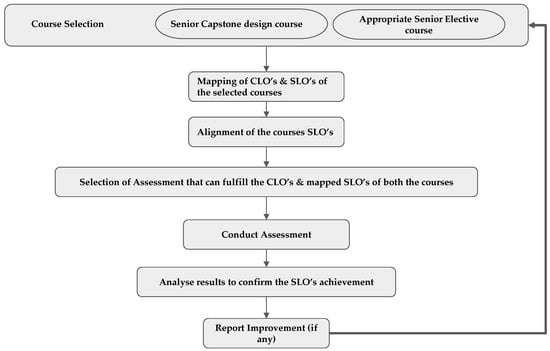
Figure 2.
Proposed Framework flowchart.
First, the courses are selected for the MPL. It is important to have one senior capstone or mandatory design course, and the other course can be any senior level elective course. Second, the Course Learning Outcomes (CLOs) with the Student Learning outcomes (SOs) are mapped, as shown in Figure 3 and Figure 4. Third, the SOs have to be decided, which is fulfilled by both the courses, i.e., stated as an alignment of the courses’ SOs in the flowchart (Figure 2). Fourth, there should be a discussion of the assessment that can be used to fulfill the CLOs and the corresponding SOs (which was already decided in the previous state) of the courses involved. Fifth, the assessment is conducted. Sixth, the results are analyzed to confirm the performance of the students and validate the effect of the framework. Finally, the scope for improvement is reported on.

Figure 3.
CLO and SO mapping of ELEC 472.
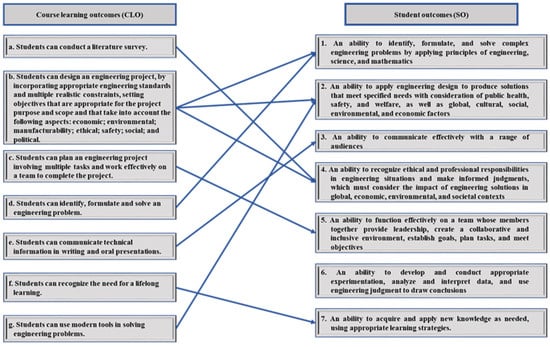
Figure 4.
CLO and SO mapping of ELEC 499.
The central crucial activity is the mapping of the CLOs with the SOs of the selected courses, which is shown in Figure 3 (for course ELEC 472) and Figure 4 (for course ELEC 499).
The project was used to evaluate the CLO “h” of ELEC 472 and the CLO “e” of ELEC 499. Each of the CLOs is associated with achieving the common SO 3.
4.2. Investigation of the Impact of MPL Implementation on Students’ Performance
This section covers the second contribution of the paper by investigating the impact of the MPL implementation on students’ overall course grade by comparing the MLP-implemented semester (that is, Spring 2020) with the previous semester. Course-wise, course grades from the two semesters were compared gender-wise and overall.
Figure 5 shows the letter grade distribution during the two semesters. A higher number of students obtained better grades (A, B+, and B) when the MPL and online assessment were implemented. Therefore, there has been a positive effect of the MPL and online assessment approach on the students’ grades in the ‘In-COVID-19 semester’. Moreover, it is also interesting to see that none of the students were in the lower grades, such as grades D and F.
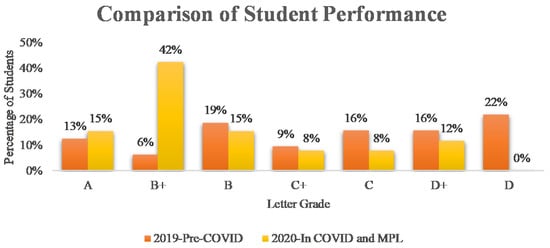
Figure 5.
Comparison of the overall course grade in the two semesters.
The improvement in student performance in the MPL implementation during the COVID-19 teaching period was also confirmed using the z-test using R-software, where the below hypothesis was accepted using the statistics in Figure 5.
Hypothesis (H0): The probability of obtaining an A and B+ is larger in MPL-designed course participants than among the non-MPL students.
4.3. The Effect of MPL Implementation
An analysis of students’ responses regarding their experience during the course shows the effect of online teaching during MPL implementation.
The survey questions was structured in such a way that the responses help to examine the conclusions of whether the students found the MPL, online assessment, and online lecturing helpful. A detailed two-sample t-test was conducted on the survey results from the Male and Female students. The responses of the students in Figure 6 were used in the two-sample t-test analysis to conclude from the student responses.
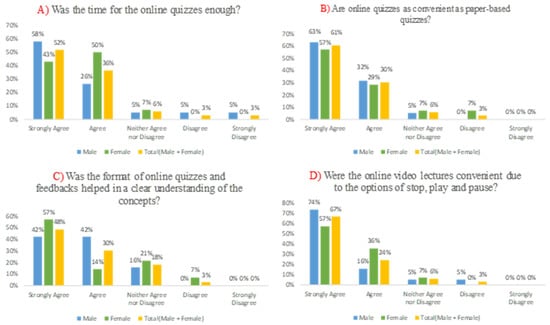
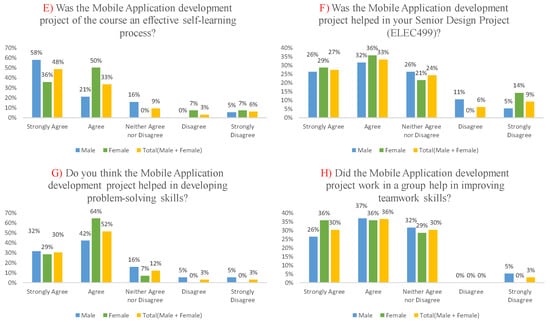
Figure 6.
Summary of the student response from the survey questions.
Table 2 summarizes the results and interpretations of the t-test analyses. This will be used to make suggestions and concluding remarks from this case study and also to assess the findings of the study. Moreover, the questions were designed specifically to obtain feedback on the online assessment technique and the MPL approach, as shown in Table 2.

Table 2.
Outcomes and conclusions from the Two-sample paired t-test on the survey answers.
4.4. The Effect of MPL Implementation Including Online Implementation Is Not by Chance
The authors assumed that the students would evaluate the MPL implementation, including the online activities, as having a positive impact compared with the reviews from the professors on the same course in the earlier semesters. This assumption was tested with the use of chi-square distribution [41] for comparing proportions from two groups [42]. All the survey questions were asked, and positive answers for the questions were predicted by the authors, i.e., the forecast of the authors. Based on the results obtained from the survey, and conducting chi-square analysis assuming alpha level (α) = 5 percent, the degree of freedom (c) = 4 (i.e., number of categories—1, there were five categories as shown in Figure 2). For all the questions, the authors have assumed the null hypothesis (H0) as: students would respond positively (Strongly Agree or Agree). This inference was analyzed with the answer observed, and chi-square analysis was conducted to validate whether the assumption should be accepted or refused.
The implementation was carried out with positive assumptions, i.e., all the students either agreed or strongly agreed with the questions as stated in the previous analysis phase section, which as confirmed with the chi-square analysis carried out on the students’ responses, as shown in Table 3. Besides this, chi-square analysis was carried out separately based on male and female responses to confirm the results. It was found that the results were similar (Table 3).

Table 3.
Chi-square statistics on survey responses.
4.5. Students’ Creative Way of Thinking
The MPL implementation was expected to engage students in group activities and demonstrate creative thinking while solving challenges together. The creativity of the students was observed while grading the final submissions. Figure 7 shows four screenshots of mobile application interfaces, which show the creative functionalities ideated for solving the problems of the respective projects. Since only one project had to be delivered instead of two different projects for the two courses, the additional time and the concepts learned from both courses enabled the students to be more creative. It is noted that creativity levels can be improved if the mobile application development project can be made a more effective self-learning process with the help of more guiding materials.
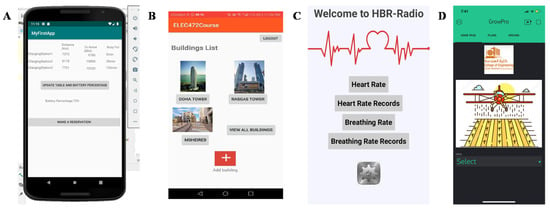
Figure 7.
Screenshots of Mobile Application developed by students linking to their ELEC 499 course. (A) Mobile Application to book EV charging station, (B) Mobile Application to book drone cleaning services for the exterior glasses of a building, (C) Mobile application to monitor the ECG of the patients, (D) Mobile application to monitor the crop health and take necessary actions using drones.
5. Conclusions
This paper has tried to analyze the use of innovative approaches and online teaching on the effect of SO’s attainment with the help of the respective assessment grades, comparing them with a previous semester where such approaches were not deployed. The paper has also answered the research questions that motivated the study by analyzing the effect of MPL on the student grades and also finding the student perceptions with the help of survey. The results are important for the research community to further improve our innovation with the proposed framework in preparation for the already existing hybrid teaching trend, which was a necessity during the COVID-19 pandemic. The adopted strategy has proven successful in promoting PBL’s core values, with certain difficulties. Some students were unable to develop their comprehension because they felt the learning was too difficult and needed additional tasks. Some students had trouble operating in groups or teams, with some students not contributing at all to the projects and others contributing heavily and upsetting other team members. The teacher must be imaginative in order to resolve the problem of increasing the motivation of such students. To enhance teacher-student relationships, teachers must be able to solve problems, especially when working with students who have low abilities, motivation, or lack concentration [11]. Furthermore, students offered suggestions that indicated steps that could be taken to enhance the experience. The students also had concerns with interaction due to online assessment and teaching. The limitations of the study can be categorized into (i) theoretical framework and the activities for the development and implementation of the multi-course project-based learning, (ii) online assessment. The limitation of the theoretical framework was discussed in detail in the discussion.
There was a limitation of the online quizzes that could be improved to make it as convenient as paper-based exams with the help of equation editors and training the students on how to use them, as the students should be able to quickly write equations in their answers and then deduce the answers. The feedback for the quiz should be more detailed and should refer to the chapter, so that the students can use it to review it for future exams and so that it can be provided immediately after the test is taken. In order to do so, a large pool of questions should be provided to avoid students who finish the exam earlier sharing the questions and answers with other students. The feedback mechanism can also help the student to understand the concepts better. The online video lectures can be posted in advance for the students to refer them before the lecture so that during the actual lecture session more interactions are made possible by letting the students ask questions.
In summary, the outcomes of this MPL study contribute more than similar works conducted in PBL-based studies [43,44,50]. This paper discusses the step-by-step implementation of MPL for a senior and capstone course, which can help attain the competencies required for ESD. This is an extension of the work done by authors for two undergraduate courses in [11]. The limitations of the study (stated in the previous paragraph) could be further improved in a future implementation. The paper also talked about how online assessment can help in improving students’ performance and learning, which is the need of the hour in pandemic situations. Some of the changes that can be made to make the methods more successful have also been outlined in this report. The authors have also found a positive response for the innovations implemented in this study, verified in Table 3. This paper discusses the effect of online assessment and MPL implementation for two senior-level courses and was designed to report the innovative teaching methods that can be useful for the pandemic situation. Innovative online teaching methods using online assessment and MPL can help in developing competencies in students to look for sustainable solutions. Positive feedback on this method was provided by the survey conducted at the end of the semester. Based on the students’ feedback, suggestions can be made that would be beneficial to improving the approach. Being an ABET accredited program and having proper linking of SOs with CLOs, as well as having clear assessments to confirm the achievement of the CLOs [28,29,52], the student grades can help in understanding the impact of the implemented approaches. This can be further confirmed with a future implementation of the framework with the suggested improvement of the limitations stated by the students. This case study will be useful for inspiring engineering programs with more of these methods. The case study of an online course along with MPL for senior-level courses can also help in adding to the existing innovative teaching practices body of knowledge.
Author Contributions
Conceptualization, A.K. and N.Z.; methodology, M.E.H.C. and M.S.K.; validation, M.S.K. and M.E.H.C.; formal analysis and investigation, all the authors; writing—original draft preparation, M.E.H.C., A.K. and N.Z.; writing—review and editing, A.K. and M.S.K. All authors have read and agreed to the published version of the manuscript.
Funding
The APC was funded by Section for Statistics and Data Analysis, Department of Applied Mathematics and Computer Science, Technical University of Denmark (DTU).
Institutional Review Board Statement
The study was conducted according to the guidelines of Ethic Committee Name: QU Ethical IRB Committee with Approval Code: QU-IRB 1434-E/2 and Approval Date: 1 January 2019.
Informed Consent Statement
Informed consent was obtained from all subjects involved in the study.
Conflicts of Interest
The authors declare no conflict of interest.
Abbreviations
| SO | Student Learning Outcome |
| CLO | Course Learning Outcome |
| ABET | Accreditation Board for Engineering and Technology |
| MPL | Multi-Course Project-Based Learning |
| ESD | Sustainable Development Education |
| ELEC 472 | Senior Course of Electrical Engineering Department of Qatar University Titled-Wireless Network and Application |
| ELEC 499 | Capstone Course of Electrical Engineering Department of Qatar University Titled -Senior Design Project II |
Appendix A
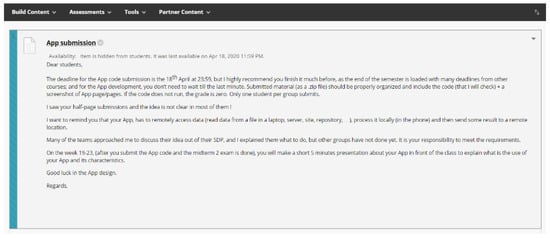
Figure A1.
Project Guidelines screenshot and Text from the Learning Management System.
References
- Wiek, A.; Withycombe, L.; Redman, C.L. Key competencies in sustainability: A reference framework for academic program development. Sustain. Sci. 2011, 6, 203–218. [Google Scholar] [CrossRef]
- van der Leeuw, S.; Wiek, A.; Harlow, J.; Buizer, J. How much time do we have? Urgency and rhetoric in sustainability science. Sustain. Sci. 2012, 7, 115–120. [Google Scholar] [CrossRef]
- Dochy, F.; Segers, M.; Vand De Bossche, P.; Gijbels, D. Effects of problem-based learning: A meta-analysis. Learn. Instr. 2003, 13, 533–568. [Google Scholar] [CrossRef]
- Dal, M. Teaching Electric Drives Control Course: Incorporation of Active Learning into the Classroom. IEEE Trans. Educ. 2013, 56, 459–469. [Google Scholar] [CrossRef]
- Saghafinia, A.; Ping, H.W.; Uddin, M.N.; Amindoust, A. Teaching of Simulation an Adjustable Speed Drive of Induction Motor Using MATLAB/Simulink in Advanced Electrical Machine Laboratory. Procedia-Soc. Behav. Sci. 2013, 103, 912–921. [Google Scholar] [CrossRef][Green Version]
- Anuchin, A.; Vagapov, Y.; Belloc, C. Development of curriculum for a postgraduate course on Electric Drives and Motion Control. In Proceedings of the 50th International Universities Power Engineering Conference (UPEC), Stoke on Trent, UK, 1–4 September 2015; pp. 1–4. [Google Scholar]
- Rusu, C.; Radulescu, M.M.; Enikö, S.; Melinda, R.K.; Jakab, Z.L. Embedded motor drive prototype platform for testing control algorithms. In Proceedings of the 2014 International Conference on Applied and Theoretical Electricity (ICATE), Craiova, Romania, 23–25 October 2014; pp. 1–6. [Google Scholar]
- Santos-Martin, D.; Alonso-Martinez, J.; Carrasco, J.E.-G.; Arnaltes, S. Problem-Based Learning in Wind Energy Using Virtual and Real Setups. IEEE Trans. Educ. 2011, 55, 126–134. [Google Scholar] [CrossRef]
- Mitchell, J.; Canavan, B.; Smith, J. Problem-Based Learning in Communication Systems: Student Perceptions and Achievement. IEEE Trans. Educ. 2009, 53, 587–594. [Google Scholar] [CrossRef]
- Petousi, V.; Sifaki, E. Contextualising harm in the framework of research misconduct. Findings from discourse analysis of scientific publications. Int. J. Sustain. Dev. 2020, 23, 149–174. [Google Scholar] [CrossRef]
- Khandakar, A.; Chowdhury, M.E.H.; Gonzales, A.J.S.P.; Touati, F.; Emadi, N.A.; Ayari, M.A. Case Study to Analyze the Impact of Multi-Course Project-Based Learning Approach on Education for Sustainable Development. Sustainability 2020, 12, 480. [Google Scholar] [CrossRef]
- Schahczenski, C.; Ackerman, F. A successful multi-course project. J. Comput. Sci. Coll. 2017, 33, 202–208. [Google Scholar]
- Xu, B.; Sheng, Y.; Wu, J.; Chen, W. Design and Implementation of Teaching for the Training Project of Multi-course. China Mod. Educ. Equip. 2017, 7, 41–43. [Google Scholar] [CrossRef]
- Sullivan, G.A.; Hardin, J.-M. The Can Crusher Project: A Multi-Semester Design Project to Enhance Retention of Engineering Skill Sets. In Proceedings of the ASME 2015 International Design Engineering Technical Conferences and Computers and Information in Engineering Conference, Boston, MA, USA, 2–5 August 2015; p. V003T04A005. [Google Scholar]
- Wijayati, N.; Sumarni, W.; Supanti, S. Improving Student Creative Thinking Skills Through Project Based Learning. KnE Soc. Sci. 2019, 3, 408–421. [Google Scholar] [CrossRef]
- Ahmed, H.; Allaf, M.; Elghazaly, H. COVID-19 and medical education. Lancet Infect. Dis. 2020, 20, 777–778. [Google Scholar] [CrossRef]
- Rose, S. Medical Student Education in the Time of COVID-19. JAMA 2020, 323, 2131–2132. [Google Scholar] [CrossRef] [PubMed]
- Kogan, M.; Klein, S.E.; Hannon, C.P.; Nolte, M.T. Orthopaedic education during the COVID-19 pandemic. J. Am. Acad. Orthop. Surg. 2020, 28, e456–e464. [Google Scholar] [CrossRef] [PubMed]
- Bambakidis, N.C.; Tomei, K.L. Impact of COVID-19 on neurosurgery resident training and education. J. Neurosurg. 2020, 133, 10–11. [Google Scholar] [CrossRef] [PubMed]
- Iyer, P.; Aziz, K.; Ojcius, D.M. Impact of COVID-19 on dental education in the United States. J. Dent. Educ. 2020, 84, 718–722. [Google Scholar] [CrossRef]
- Bao, W. COVID-19 and online teaching in higher education: A case study of Peking University. Hum. Behav. Emerg. Technol. 2020, 2, 113–115. [Google Scholar] [CrossRef]
- Laskaris, D.; Kalogiannakis, M.; Heretakis, E. ‘Interactive evaluation’ of an e-learning course within the context of blended education. Int. J. Technol. Enhanc. Learn. 2017, 9, 339–353. [Google Scholar] [CrossRef]
- Laskaris, D.; Heretakis, E.; Kalogiannakis, M.; Ampartzaki, M. Critical reflections on introducing e-learning within a blended education context. Int. J. Technol. Enhanc. Learn. 2019, 11, 413–440. [Google Scholar] [CrossRef]
- Aziz, A.; Hashem, M.M.A. Fuzzy Logic-Based Assessment of Students Learning Outcome in Implementing Outcome-Based Education. In Proceedings of the International Conference on Big Data, IoT, and Machine Learning (BIM 2021), Cox’s Bazar, Bangladesh, 23–25 September 2021; pp. 745–759. [Google Scholar]
- Alhakami, H.H.; Al-Masabi, B.A.; Alsubait, T.M. Data Analytics of Student Learning Outcomes Using Abet Course Files. In Intelligent Computing, Proceedings of the Science and Information Conference (SAI 2020), London, UK, 16–17 July 2020; Springer: Cham, Switzerland, 2020; pp. 309–325. [Google Scholar]
- Sarker, N.N.; Ketkar, M.A. Multiple Assessments and Continuous Improvement of Engineering Technology Programs. In 2006 GSW, Proceedings of the 2006 ASEE Gulf-Southwest Annual Conference, Baton Rouge, LA, USA, 6–10 March 2006; American Society for Engineering Education: Washington, DC, USA, 2022. [Google Scholar] [CrossRef]
- Saeed, S.; Almuhaideb, A.M.; Bamarouf, Y.A.; Alabaad, D.A.; Gull, H.; Saqib, M.; Iqbal, S.Z.; Salam, A.A. Sustainable Program Assessment Practices: A Review of the ABET and NCAAA Computer Information Systems Accreditation Process. Int. J. Environ. Res. Public Health 2021, 18, 12691. [Google Scholar] [CrossRef] [PubMed]
- Hussain, W.; Spady, W.G.; Naqash, M.T.; Khan, S.Z.; Khawaja, B.A.; Conner, L. ABET Accreditation during and after COVID19-Navigating the Digital Age. IEEE Access 2020, 8, 218997–219046. [Google Scholar] [CrossRef] [PubMed]
- Hussain, W.; Spady, W.G.; Khan, S.Z.; Khawaja, B.A.; Naqash, T.; Conner, L. Impact Evaluations of Engineering Programs Using ABET Student Outcomes. IEEE Access 2021, 9, 46166–46190. [Google Scholar] [CrossRef]
- Supernak, J.; Ramirez, A.; Supernak, E. COVID-19: How Do Engineering Students Assess its Impact on Their Learning? Adv. Appl. Sociol. 2021, 11, 14–25. [Google Scholar] [CrossRef]
- Szopiński, T.; Bachnik, K. Student evaluation of online learning during the COVID-19 pandemic. Technol. Forecast. Soc. Chang. 2022, 174, 121203. [Google Scholar] [CrossRef] [PubMed]
- Kolmos, A.; Holgaard, J.E.; Dahl, B. Reconstructing the Aalborg model for PBL: A case from the faculty of engineering and science, Aalborg University. In PBL across Cultures; Aalborg Universitetsforlag: Aalborg, Denmark, 2013; pp. 289–296. [Google Scholar]
- Barrows, H.S. Problem-based learning in medicine and beyond: A brief overview. New Dir. Teach. Learn. 1996, 1996, 3–12. [Google Scholar] [CrossRef]
- Gijselaers, W.H. Connecting problem-based practices with educational theory. New Dir. Teach. Learn. 1996, 1996, 13–21. [Google Scholar] [CrossRef]
- Rekola, J.; Messo, T. Application of problem-based learning method for a course on modeling and control of electric drives. In Proceedings of the IECON 2017-43rd Annual Conference of the IEEE Industrial Electronics Society, Beijing, China, 29 October–1 November 2017; pp. 3583–3588. [Google Scholar]
- Barge, S. Principles of Problem and Project Based Learning: The Aalborg PBL Model; Aalborg University: Aalborg, Denmark, 2010. [Google Scholar]
- Kolmos, A.; Fink, F.K.; Krogh, L. The Aalborg PBL Model: Progress, Diversity and Challenges; Aalborg University Press: Aalborg, Denmark, 2004. [Google Scholar]
- Jonassen, D.H.; Hung, W. All Problems Are Not Equal: Implications for Problem-Based Learning. In Essential Readings in Problem-Based Learning; Purdue University Press: West Lafayette, IN, USA, 2015; pp. 17–41. [Google Scholar]
- Hmelo-Silver, C.E. Problem-based learning: What and how do students learn? Educ. Psychol. Rev. 2004, 16, 235–266. [Google Scholar] [CrossRef]
- Gijbels, D.; Dochy, F.; Bossche, P.V.D.; Segers, M. Effects of Problem-Based Learning: A Meta-Analysis from the Angle of Assessment. Rev. Educ. Res. 2005, 75, 27–61. [Google Scholar] [CrossRef]
- Lozano, R.; Barreiro-Gen, M.; Lozano, F.J.; Sammalisto, K. Teaching Sustainability in European Higher Education Institutions: Assessing the Connections between Competences and Pedagogical Approaches. Sustainability 2019, 11, 1602. [Google Scholar] [CrossRef]
- Jabarullah, N.H.; Hussain, H.I. The effectiveness of problem-based learning in technical and vocational education in Malaysia. In Education+ Training; Emerald Publishing Limited: Bingley, UK, 2019. [Google Scholar]
- Singer-Brodowski, M.; Brock, A.; Etzkorn, N.; Otte, I. Monitoring of education for sustainable development in Germany–insights from early childhood education, school and higher education. Environ. Educ. Res. 2019, 25, 492–507. [Google Scholar] [CrossRef]
- Nguyen, T.P. Searching for education for sustainable development in Vietnam. Environ. Educ. Res. 2019, 25, 991–1003. [Google Scholar] [CrossRef]
- Project Management Institute. A Guide to the Project Management Body of Knowledge (PMBOK® Guide); Project Management Institute: Newtown Square, PA, USA, 2001; pp. 7–8. [Google Scholar]
- Reich, B.H.; Wee, S.Y. Searching for Knowledge in the Pmbok® Guide. Proj. Manag. J. 2006, 37, 11–26. [Google Scholar] [CrossRef]
- Polikoff, M.S. The Stability of Observational and Student Survey Measures of Teaching Effectiveness. Am. J. Educ. 2015, 121, 183–212. [Google Scholar] [CrossRef]
- Boehler, M.L.; Rogers, D.A.; Schwind, C.J.; Fortune, J.; Ketchum, J.; Dunnington, G. A senior elective designed to prepare medical students for surgical residency. Am. J. Surg. 2004, 187, 695–697. [Google Scholar] [CrossRef]
- Sageev, P.; Romanowski, C.J. A Message from Recent Engineering Graduates in the Workplace: Results of a Survey on Technical Communication Skills. J. Eng. Educ. 2001, 90, 685–693. [Google Scholar] [CrossRef]
- Khandakar, A.; Chowdhury, M.E.H.; Ahmed, R.; Dhib, A.; Mohammed, M.; Al-Emadi, N.A.M.A.; Michelson, D. Portable System for Monitoring and Controlling Driver Behavior and the Use of a Mobile Phone While Driving. Sensors 2019, 19, 1563. [Google Scholar] [CrossRef]
- Kalogiannakis, M.; Touvlatzis, S. Emotions Experienced by Learners and their Development through Communication with the Tutor-Counsellor. Eur. J. Open Distance E-Learn. 2015, 18, 36–48. [Google Scholar] [CrossRef]
- Enderle, J.; Gassert, J.; Blanchard, S.; King, P.; Beasley, D.; Hale, P.J.; Aldridge, D. The ABCs of preparing for ABET. IEEE Eng. Med. Biol. Mag. 2003, 22, 122–132. [Google Scholar] [CrossRef]
Publisher’s Note: MDPI stays neutral with regard to jurisdictional claims in published maps and institutional affiliations. |
© 2022 by the authors. Licensee MDPI, Basel, Switzerland. This article is an open access article distributed under the terms and conditions of the Creative Commons Attribution (CC BY) license (https://creativecommons.org/licenses/by/4.0/).